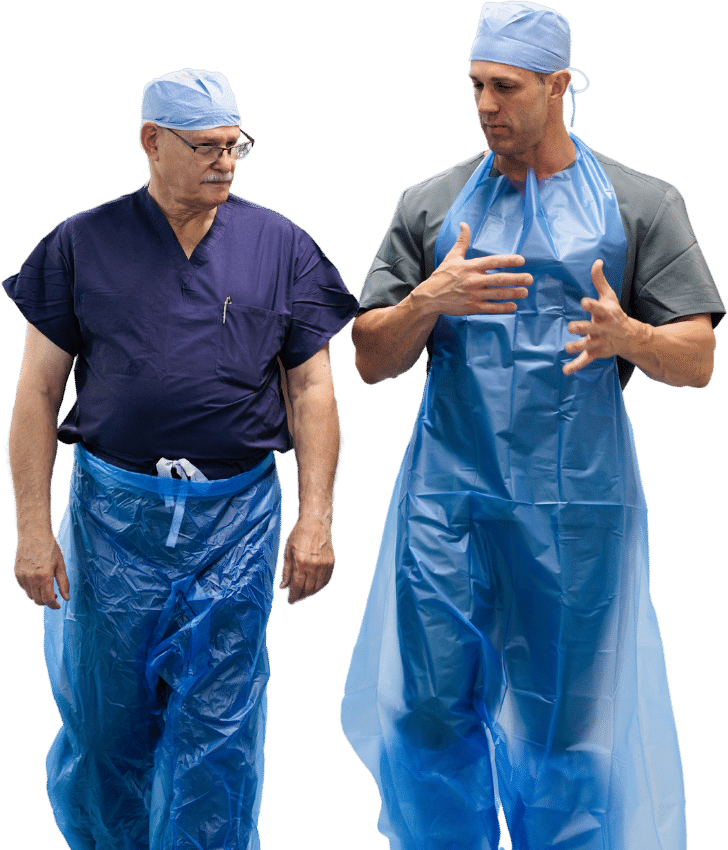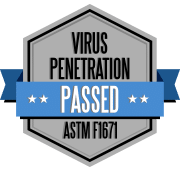Let’s play “Guess Who?”
Clues: I’m everywhere in your hospital or surgical center. You use me every day. And you know there’s a right way and a wrong way to deal with me. No, I’m not your hospital administrator… I’m your disposable PPE!
All jokes aside, every healthcare worker knows how important disposable PPE is to safety, infection control, and patient care. It serves as the first, all-important barrier from pathogens in health care environments and workplaces. Knowing how to put it on, take it off, and dispose of it properly is the other half of the battle.
Properly donning and doffing PPE means getting the protection you paid for against infections and preventing their spread. Wearing the equipment is one thing; getting the sequence right is another. From head to toe, from face shields to shoe covers, use this guide to make sure you’re donning, doffing, and disposing of your PPE the right way.
Why use disposable protective accessories and apparel?
Disposable protective clothing, like disposable aprons, disposable jumpsuits, and disposable coveralls, provides excellent infection control. Compared to reusable PPE options, your disposables reduce the risk of contamination and they’re much easier to doff and dispose of.
Benefits of Disposable PPE:
- Superior Hygiene: These items are designed for one-time use. They’re always clean and ready, minimizing infection risks.
- Convenience and Ease of Use: Disposable jumpsuits, coveralls, and gloves are easy to wear and remove.
- Minimized Cross-Contamination: Each use involves fresh gear, lowering the chance of spreading germs.
- Ease of Disposal: You can quickly dispose of them, reducing handling time.
For safety during public health emergencies like the COVID-19 pandemic, disposable PPE is a far better choice.
Donning your PPE in the right order
Donning your personal protective equipment (PPE) properly is the first step in your infection control process! Once you know the risk level of the procedure you’re about to perform, select the set of PPE that matches your task. Then, it’s time to get dressed!
Here’s a step-by-step guide to donning a full set of surgical PPE:
- Hand Hygiene: Wash or sanitize your hands thoroughly.
- Gown or Jumpsuit: Put on the surgical gown, disposable apron, disposable coveralls, or disposable jumpsuit. Secure it by tying the back or otherwise fastening it.
- Mask: Place a surgical mask over your nose and mouth. Ensure it’s snug, covering your nose and chin.
- Shoe Covers/Leggings: Slip on your shoe covers, leggings, or pant protectors. Ensure they cover your shoes completely without gaps.
- PPE Apron: Wear a PPE apron over your gown for additional protection.
- Face Shield or Goggles: Position the face shield or goggles securely over your mask. Ensure they fit comfortably and don’t obstruct vision.
- Gloves: Lastly, put on disposable gloves. Extend them to cover the gown’s cuffs for full protection.
Remember, this order minimizes the risk of contamination. Ensure each piece fits well to maintain maximum safety!
Doffing your PPE in the right order
The procedure is over – congratulations, it looks like it was a success! Time to doff your PPE kit. The doffing process is all about avoiding self-contamination. Here’s a step-by-step guide:
- Preparation:
- Ensure you are in a designated doffing area.
- Have a waste container ready for the disposal of your PPE.
- Remove Gloves:
- Grasp the outside of one glove at the wrist, taking care not to touch your skin.
- Peel the glove away from your hand, turning it inside out.
- Hold the removed glove in the gloved hand.
- Slide your fingers under the wrist of the remaining glove, avoiding contact with the outside.
- Peel the second glove off over the first glove, turning it inside out as well, and dispose of both gloves safely.
- Perform Hand Hygiene:
- Clean your hands with an alcohol-based hand sanitizer or soap and water.
- Remove Gown, Jumpsuit, Apron or Coveralls:
- Unfasten the disposable medical apparel’s ties, if necessary, and pull the item away from your body, touching only the inside.
- Roll the gown away from your body, turning it inside out, and dispose of it properly. (See below!)
- Perform Hand Hygiene Again:
- Clean your hands once more to remove any contaminants.
- Remove Protective Eyewear or Face Shield:
- Handle face protection by the headband or ear pieces to avoid touching the front of the piece.
- Remove Mask or Respirator:
- For masks: Remove by handling the ear loops or ties, starting with the bottom tie if applicable, then the top tie, ensuring you do not touch the front of the mask.
- For respirators: Tilt your head slightly forward, grasp the bottom strap and bring it up over your head, followed by the top strap, and then remove the respirator forward and away from your face.
- Dispose of the mask or respirator appropriately.
- Perform Hand Hygiene:
- Once all PPE is removed, perform a final hand hygiene step to ensure hands are clean.
- Final Checks:
- Report any contamination incidents to your supervisor or as per your facility’s protocol.
Following this structured process helps minimize the risk of self-contamination and cross-contamination and maintains a safe environment for staff and patients. Download our infographic poster for your locker room!
Disposing of your PPE in the right way
Now that it’s all off, where does all that used PPE go?
Proper disposal of your disposable PPE, such as coveralls, gowns, masks, and gloves, is crucial. Improper disposal can lead to contamination and negative environmental impacts. Follow these steps to safely dispose of your PPE:
- Separate Waste: Sort used PPE as hazardous or general waste. PPE from healthcare settings or contaminated areas is generally regarded as hazardous.
- Use the Proper Bins: Place the PPE in your facility’s designated waste bins. Ensure these bins are labeled correctly, such as “biohazard” for PPE that’s come into contact with blood or bodily fluids.
- Seal Properly: Seal your waste bags securely. Use bags that are puncture-resistant. Double bag if needed to prevent leaks.
- Dispose Responsibly: Your facility’s waste management company will handle this hazardous waste. They’ll ensure it’s incinerated or processed without harming the environment or contaminating others.
- Wash Your Hands Again, Just in Case: Always wash your hands with soap and water after handling used PPE.
FAQ: All about disposable PPE
Disposable PPE seems simple, but we get a lot of questions about disposal, reuse, contamination, and the general benefits of these ubiquitous items. Here are a few frequently asked questions, and the answers from our experts:
What are the risks of improper disposal of used PPE?
Improper disposal of used PPE can lead to serious health and environmental risks. When used PPE is not disposed of correctly, it poses a risk of spreading contamination.
This is particularly concerning in healthcare settings where exposure to harmful substances and infections is high. PPE that is contaminated can carry viruses and bacteria, spreading them to others. Furthermore, carelessly discarded PPE contributes to plastic waste, impacting the environment negatively. It can take hundreds of years for plastic waste to decompose, causing long-term harm to ecosystems. Proper disposal procedures need to be followed to mitigate these risks.
Can disposable PPE be reused?
Disposable PPE is designed for single use and should not be reused. These items are intended to provide a barrier against contamination for one-time use, ensuring maximum protection each time. Reusing disposable PPE can significantly compromise its effectiveness and increase the risk of contamination.
It’s important to differentiate between disposable PPE and single-patient PPE, such as ezGLIDE patient transfer sheets. While single-patient PPE like ezGLIDE sheets may be reused for the same patient through many transfers and procedures, items labeled disposable, like gowns, aprons, and gloves, should only be used for one procedure. This distinction ensures hygiene and safety in healthcare and other environments.
Where can you dispose of contaminated PPE?
Medical professionals must dispose of contaminated PPE in designated locations to ensure safety. Contaminated PPE should be treated as hazardous or clinical waste and disposed of in specially marked bins. These bins are often labeled as “biohazard” and are used to segregate dangerous waste from general trash. Once collected, waste management companies usually handle the disposal. These companies ensure that the waste is incinerated or treated to prevent environmental harm. By following these protocols, healthcare facilities can minimize the risk of spreading contaminants and protect public health.
What are the benefits of disposable PPE?
Disposable PPE offers several advantages over reusable options. One major benefit is superior hygiene and infection control. By using items only once, there’s a reduced risk of contamination between users. Disposable PPE is also convenient and easy to use, requiring no washing or maintenance. This convenience saves time and resources, especially in fast-paced environments like hospitals. They’re also designed for easy disposal, simplifying waste management procedures. Moreover, disposable PPE minimizes the risk of cross-contamination, ensuring a high level of safety for individuals and patients alike. These benefits contribute to their widespread use in healthcare and other industries.
Is PPE considered clinical waste?
Whether PPE is considered clinical waste depends on its usage and contamination level. In healthcare settings, used PPE often qualifies as clinical waste. This is because it might be contaminated with bodily fluids, infectious agents, or other hazardous substances. Clinical waste requires special handling and disposal methods. Proper disposal is critical to prevent potential health risks associated with exposure to harmful materials. Outside of healthcare, PPE may not always be classified as clinical waste unless it becomes contaminated. Understanding the circumstances and proper disposal guidelines ensures compliance with health regulations and safety standards.
Stay Safer and Drier with STA-DRI
Donning, doffing, and disposing of your disposable PPE are all components of the master plan to keep staff and patients safe from pathogens and bloodborne illnesses. Each part of the plan is just as important as the rest, so regularly training your team and refreshing their memories on the right order of operations is always a good idea.
Speaking of good ideas, here’s another one: investing in premium PPE guaranteed to keep the goop off you, your scrubs, and your shoes. At Sloan Medical, we’ve designed our PPE garments to be lightweight, durable, and—yes—impenetrable.Our STA-DRI garments were explicitly designed for healthcare professionals by urologist Dr. Stewart Sloan. See the difference that PPE made by surgeons, for surgeons can make! Try a free sample pack of our best PPE ever.





